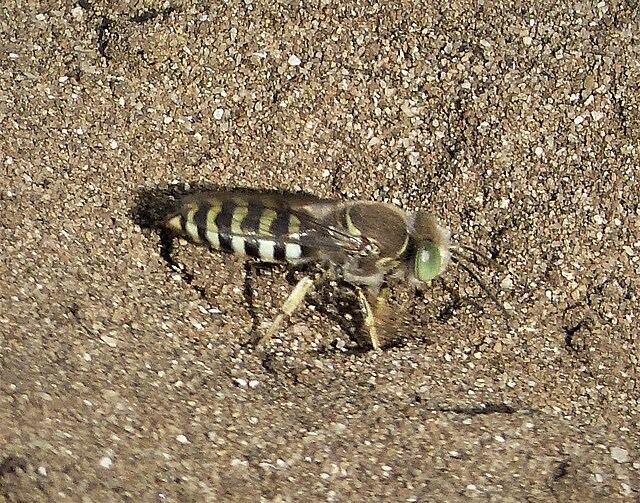
FILE PHOTO - A sand wasp is pictured in this undated photo from Wikimedia Commons.
Image Credit: WIKIMEDIA COMMONS/Gail Hampshire
July 18, 2024 - 6:00 AM
A woman in the South Okanagan caught an interesting insect digging a hole in the sand on her property in Osoyoos a few days ago.
Kathryn Ilse watched and recorded a solitary sand wasp industriously burrowing in the sand for a few seconds before flying away.
“The wasp was there for a few minutes so my daughter spotted it and pointed it out to my son and he showed me because it was so cool," she said. "We thought it was a bee, we’d never seen this before.”
There are several different species of sand wasps and they are different from most wasp species like yellowjackets in that they are solitary and don’t live in colonies. The the female sand wasp makes her own burrow with a long tunnel and chambers at the end using her mandibles.
The female sand wasp will lay eggs in the burrow chambers and hunt for flies to feed the larva, catching a fly by its wing and paralyzing it in the air. When the larva is ready to pupate the female leaves and closes the chamber where larva pupate in a cocoon using sand grains that give it a hard shell, and emerge as sand wasps the following year, according to What's That Bug.
All the male sand wasp has to do is mate. In spring, the male emerges first and does a sun dance, flying at high speeds just above the ground until the females emerge. If a female isn’t pounced upon immediately after emerging, she joins a male wasp in flight and they finish mating elsewhere, but if the pair falls to the ground the other males will fight to overthrow the first male in order to mate.
Identified by its yellow and black, or white and black banded bodies, an adult sand wasp feeds on flower nectar and pollen and can be found in sandy habitats in urban areas, forests and woodlands.
Sand wasps rarely sting or bite and are not poisonous.
The females wasps dig the burrows in mere seconds.
“We are learning about sand wasps and my son is keen to find out more, it has been a lot of fun," Ilse said.
To contact a reporter for this story, email Shannon Ainslie or call 250-819-6089 or email the editor. You can also submit photos, videos or news tips to the newsroom and be entered to win a monthly prize draw.
We welcome your comments and opinions on our stories but play nice. We won't censor or delete comments unless they contain off-topic statements or links, unnecessary vulgarity, false facts, spam or obviously fake profiles. If you have any concerns about what you see in comments, email the editor in the link above. SUBSCRIBE to our awesome newsletter here.
News from © iNFOnews, 2024